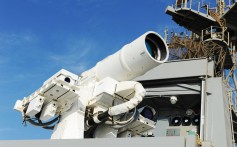The country risks falling behind its major strategic rival, defence analysts say
Washington is trying to develop portable laser weapons, but some observers believe this may be a long way off
Kristin Huang
SCMP.COM

A US warship fires at a training target in December 2021. Photo: handout
China should speed up the development of laser weapons to keep pace with the swift progress made by the United States, Chinese military analysts have said.
The US Government Accountability Office said last week that the Pentagon is spending US$1 billion a year on developing directed energy weapons to counter threats such as drones and missiles.
It said much recent research has focused on making laser weapons small and light enough to be used by one person, but is still facing a challenge in moving beyond the prototype stage.
Laser weapons are seen as a good solution to the use of drone swarms, which have been widely used in modern conflicts such as the Ukraine war.
A laser beam can confuse a drone’s optical sensor, or burn a hole when its power is increased.
The United States has been researching the technology since the 1960s and the country is a frontrunner in developing and using directed energy weapons.
US bid to ‘outcompete’ China yields its largest-ever defence budget
14 Mar 2023

In 2014, the US navy installed its first laser weapon system, the AN/SEQ-3, on the USS Ponce for field tests that proved successful.
Last year the US navy installed its first permanent laser on its Arleigh Burke–class destroyer the Preble. Lockheed Martin, which developed the Helios laser system, said it is most useful in attacking drones and small surface ships.
China has also been researching the use of laser weapons and has had some successes, such as the Silent Hunter, an anti-drone system developed by Poly Technologies.
In March last year, Saudi Arabia used the technology to intercept and destroy 13 suicide drones operated by Houthi militants in Yemen.
But Zhou Chenming, a researcher with the Beijing-based Yuan Wang military science and technology think tank, said China has to put more effort into developing high-powered laser weapons.
“China is good at making smaller laser weapons, such as the Silent Hunter, but China doesn’t have more powerful ones that can intercept bigger targets like missiles or ones that can be installed at naval vessels.
Chinese scientists build hypersonic generator to power futuristic weapons
2 Feb 2023

“I believe this is the direction that China can go in when developing and expanding the country’s own laser technology,” said Zhou.
He said “another promising direction” would be to fit laser weapons to warplanes, because they could be used at high altitudes and would be less affected by dust and rain.
Sean McFate, a professor at Syracuse University’s Maxwell School and Georgetown University’s School of Foreign Service, said despite the heavy US investment in the technology, there were still limitations.
Philippines files protest to embassy over Chinese coastguard’s use of laser
14 Feb 2023

“Everyone wants light and portable laser weapons but it’s far off. Essentially, you also need a portable power plant, which is unrealistic… Lasers are more hype than reality, and the US is investing US$1 billion a year to bridge this gap. However, it may go on for years,” said McFate.
Song Zhongping, a former PLA instructor, said China should invest more into researching directed energy weapons.
“Lasers are an important part of modern technology. China doesn’t just need laser technology, but also has to apply lasers in certain fields, such as the battlefield,” said Song.

A US warship fires at a training target in December 2021. Photo: handout
China should speed up the development of laser weapons to keep pace with the swift progress made by the United States, Chinese military analysts have said.
The US Government Accountability Office said last week that the Pentagon is spending US$1 billion a year on developing directed energy weapons to counter threats such as drones and missiles.
It said much recent research has focused on making laser weapons small and light enough to be used by one person, but is still facing a challenge in moving beyond the prototype stage.
Laser weapons are seen as a good solution to the use of drone swarms, which have been widely used in modern conflicts such as the Ukraine war.
A laser beam can confuse a drone’s optical sensor, or burn a hole when its power is increased.
The United States has been researching the technology since the 1960s and the country is a frontrunner in developing and using directed energy weapons.
US bid to ‘outcompete’ China yields its largest-ever defence budget
14 Mar 2023

In 2014, the US navy installed its first laser weapon system, the AN/SEQ-3, on the USS Ponce for field tests that proved successful.
Last year the US navy installed its first permanent laser on its Arleigh Burke–class destroyer the Preble. Lockheed Martin, which developed the Helios laser system, said it is most useful in attacking drones and small surface ships.
China has also been researching the use of laser weapons and has had some successes, such as the Silent Hunter, an anti-drone system developed by Poly Technologies.
In March last year, Saudi Arabia used the technology to intercept and destroy 13 suicide drones operated by Houthi militants in Yemen.
But Zhou Chenming, a researcher with the Beijing-based Yuan Wang military science and technology think tank, said China has to put more effort into developing high-powered laser weapons.
“China is good at making smaller laser weapons, such as the Silent Hunter, but China doesn’t have more powerful ones that can intercept bigger targets like missiles or ones that can be installed at naval vessels.
Chinese scientists build hypersonic generator to power futuristic weapons
2 Feb 2023

“I believe this is the direction that China can go in when developing and expanding the country’s own laser technology,” said Zhou.
He said “another promising direction” would be to fit laser weapons to warplanes, because they could be used at high altitudes and would be less affected by dust and rain.
Sean McFate, a professor at Syracuse University’s Maxwell School and Georgetown University’s School of Foreign Service, said despite the heavy US investment in the technology, there were still limitations.
Philippines files protest to embassy over Chinese coastguard’s use of laser
14 Feb 2023

“Everyone wants light and portable laser weapons but it’s far off. Essentially, you also need a portable power plant, which is unrealistic… Lasers are more hype than reality, and the US is investing US$1 billion a year to bridge this gap. However, it may go on for years,” said McFate.
Song Zhongping, a former PLA instructor, said China should invest more into researching directed energy weapons.
“Lasers are an important part of modern technology. China doesn’t just need laser technology, but also has to apply lasers in certain fields, such as the battlefield,” said Song.
No comments:
Post a Comment